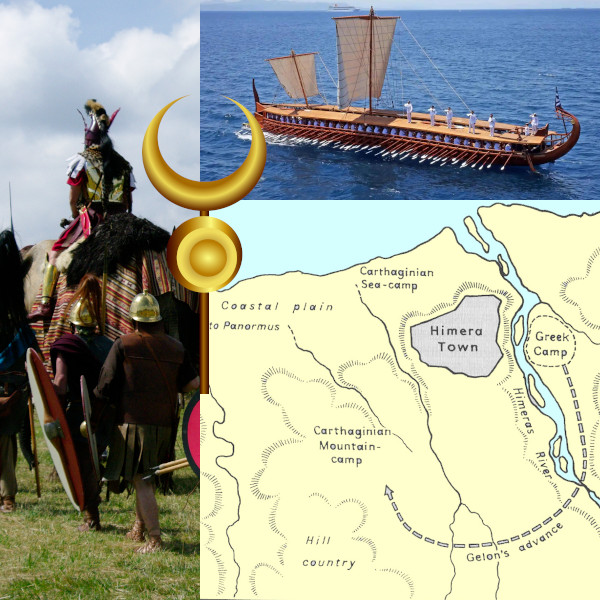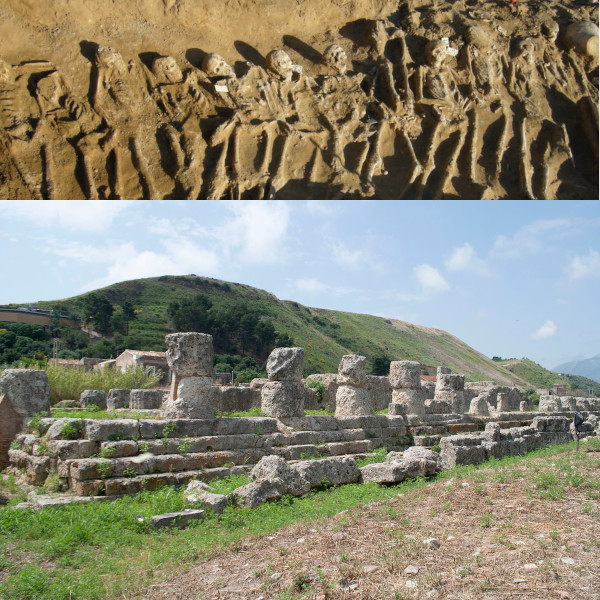DNA spotlight
Ancient Battle of Himera I
Sicily was located at the focal point of many trade routes of the known world. Three ancient tribes had inhabited the island - the Elimi, Sicani and Siculi. However the island was strategically located with fertile lands and coastline which brought settlers from Phoenicia and Ancient Greece. As the Phoenician homeland of Tyre collapsed, their once city-state turned empire Carthage set its eyes on conquering nearby Sicily. Carthage was indeed mighty and rich boasting the most powerful navy found anywhere. With their accumulated wealth they could pay for the best troops from their spheres of influence which included fierce Iberian warriors, Gauls, Sardinians, Nubian elephants and North African cavalry. Carthage signed a treaty with fledgling state of Rome, who was then battling the Etruscans to formalize plans for division of influence, and in 480 BC dispatched King Hamilcar I with the largest army yet assembled (nearly 300,000 soldiers and 5,000 horsemen) to crush several Greek city-states in Sicily as a broader plan to seize the island. The Greek colonies in Sicily meanwhile had become powerful city states with several tyrant kings as their rulers. Two in particular, Gelon and Theron had forged an alliance to claim much of the Sicilian coastline. Against the vast Carthaginian juggernaut headed their way, the Sicilian Greeks were desperate for help - they asked the Greek mainland for help but simultaneously, as fate had it, the mighty Persian Empire led by Xerxes were on their own campaign to crush the Greek homeland. The help that did arrive, as it turned out, were not Greek at all but paid mercenaries from Central and Baltic Europe. Altogether the Greeks managed to amass only 50,000 soldiers and several thousand cavalry - they were vastly outnumbered.

Poseidon favored the Greeks and sent a fierce storm which sunk many of the Carthaginian ships - including all of their chariots and most of their horses. Hamilcar had to pause to regroup providing valuable time for Gelon and Theron to collect their forces. Hamilcar strategically built two camps - one by the sea for his naval forces and one on a hill west of Himera for his land forces - both connected by a protective palisade to transfer resources back and forth. Hamilcar took the initiative and defeated a force of Greek hoplites in a pitched battle close to the city. The Greek forces were forced into retreat behind their defensive walls. The Carthaginians pillaged the nearby countryside with apparent impunity - however this included sending the reduced Carthaginian cavalry which by chance encountered the fresh Greek forces of Gelon just arriving from the East. Despite a huge army, Hamilcar had made a critical mistake in losing his valuable cavalry and dispatched a message to his Ionian Greek allies to the south for more. Gelon intercepted the messengers and cleverly did the unexpected - he sent part of his own cavalry to come from the South and disguised them as Ionian Greeks. These badly needed re-enforcements were welcomed into the naval camp of Hamilcar with open arms where they settled in and waited to spring the trap. Keep in mind Carthage was a mighty naval Empire but for land troops relied mostly on foreign mercenaries - they were unable to recognize the concealed enemy troops until too late.
A few hours later the main forces of Gelon arrived and faced the more numerous Carthaginian land forces in a massive pitched battle which was effectively a standstill with the battle swaying back and forth creating massive casualties on both sides. Mass military graves were discovered here west of Himera which we hilight in this DNA Spolight. Bodies contained deep wounds caused by spears, swords, daggers, and arrows.At this critical moment the sea camp trap was sprung - with utter precision the Greek cavalry rushed and killed Hamilcar himself who was performing a sacrificial ritual and set fire to his ships - only a few escaped. Thereupon the cavalry raised the signals and the all remaining Greek forces engaged. The Carthaginians were demoralised having lost their great leader and seeing their fleet burning in the distance. Nonetheless the elite Iberian mercenaries of Carthage held strong and actually managed to reverse the battle briefly - however the army of Theron previously waiting inside Himera arrived now and flanked them - the Carthaginians were entirely in disarray and fled in all directions. Gelon had given the order to take no prisoners so there followed a massive slaughter of all Carthaginians in their flight - no less than 150000 were slain in this manner - many out of water to drink and with no ships to flee to. The few who did escape and find ships once again met the wrath of Poseidon. A massive storm appeared from nowhere and sunk what was left of the once mighty fleet. Only a handful of Carthaginians returned and the first Battle of Himera marked a spectacular defeat for the Carthaginians who took decades to rebuild their forces.

The victory was celebrated endlessly across the entire Greek world - who had simultaneously and unbelievably defied annihilation against both the mighty Carthaginians from the West and the unstoppable Persian Empire from the East. Conspiracy of superpowers? Possibly. The Greeks were satisfied with their victory and decided not to harshly punish the Carthaginian invaders - Carthage was expecting a counter-invasion at home and was shocked to end up paying only 2000 talents of silver to make peace. This DNA spotlight focuses on the Greek warriors who fell in this battle, as well as their mercenary allies from the North. All these bodies were recovered from mass graves which had honoured the fallen - ethnic Greek graves were more private and mercenaries were buried in larger yet respectful graves. Greeks were proud of their ethnic group and legends - as a result stories of the event mention only the Greek warriors but DNA and archaeology show the true story was a combined effort by the outnumbered Greeks. However peace would not be lasting... the First Sicilian Wars later was followed by the Second. And a few hundred years later as Rome had grown strong, began the famous Carthaginian Punic Wars against the Roman Republic - which were also fought over Sicilian soil. Shown here are the ruins of Himera as seen today - not far from modern Palermo. The skeletons above are from one of the many mass graves found containing Greek soldiers and their allies.
Sample: Ancient Greek Warrior First Sicilian War Himera Sicily
- Sample ID: I7217
- Year: 480 BC
- Sex: Male
- Location: 37.972296,13.824736
Sample: Ancient Greek Warrior First Sicilian War Himera Sicily
- Sample ID: I7218
- Year: 480 BC
- Sex: Male
- Location: 37.972296,13.824736
Sample: Ancient Greek Warrior First Sicilian War Himera Sicily
- Sample ID: I7219
- Year: 480 BC
- Sex: Male
- Location: 37.972296,13.824736
Sample: Ancient Greek Warrior First Sicilian War Himera Sicily
- Sample ID: I7221
- Year: 480 BC
- Sex: Male
- Location: 37.972296,13.824736
Sample: Ancient Mercenary First Sicilian War Himera Sicily
- Sample ID: I10944
- Year: 480 BC
- Sex: Male
- Location: 37.972296,13.824736
Sample: Ancient Mercenary First Sicilian War Himera Sicily
- Sample ID: I10949
- Year: 480 BC
- Sex: Male
- Location: 37.972296,13.824736
Sample: Ancient Mercenary First Sicilian War Himera Sicily
- Sample ID: I17870
- Year: 480 BC
- Sex: Male
- Location: 37.972296,13.824736
Sample: Ancient Mercenary First Sicilian War Himera Sicily
- Sample ID: I17872
- Year: 480 BC
- Sex: Male
- Location: 37.972296,13.824736



